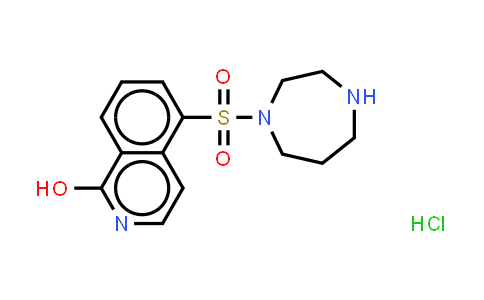| Chemical Name |
Hydroxyfasudil (hydrochloride) |
| CAS Number |
155558-32-0 |
| MDL Number |
MFCD06411567 |
| Molecular Formula |
C14H18ClN3O3S |
| Molecular Weight |
343.83 |
| Synonyms |
HA-1100 hydrochloride;HA 1100 hydrochloride;HA1100 hydrochloride |
Introduction of 155558-32-0 :
Hydroxyfasudil hydrochloride is a ROCK inhibitor, with IC50s of 0.73 and 0.72 μM for ROCK1 and ROCK2, respectively. IC50 & Target: IC50: 0.73 μM (ROCK1), 0.72 μM (ROCK2)[1] In Vitro: Hydroxyfasudil hydrochloride is a ROCK inhibitor, with IC50s of 0.73 and 0.72 μM for ROCK1 and ROCK2, respectively. Hydroxyfasudil also less potently inhibits PKA, with an IC50 of 37 μM, 50-fold higher than those of the ROCKs. Hydroxyfasudil increases eNOS mRNA levels, with an EC50 value of 0.8 ± 0.3 μM. Hydroxyfasudil (0-100 μM) concentration-dependently increases eNOS activity and stimulates NO production in human aortic endothelial cells (HAEC). Hydroxyfasudil (10 μM) increases the half-life of eNOS mRNA from 13 to 16 hours, but does not affect eNOS promoter activity at concentrations from 0.1 to 100 μM[1]. In Vivo: Hydroxyfasudil (10 mg/kg, i.p.) significantly increases both the average and maximal voided volumes in SD rats. Hydroxyfasudil also significantly decreases the maximal detrusor pressure[2]. Hydroxyfasudil (3 mg/kg, i.p) inhibits hypercontractility induced by norepinephrine in spontaneously hypertensive rats (SHRs). Furthermore, Hydroxyfasudil (3, 10 mg/kg, i.p) significantly ameliorates decreased penile cGMP contents in rats[3].
| Purity |
NLT 98% |
| Storage |
at 20ºC 2 years |
*The above information is for reference only.
